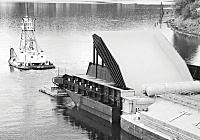forum
library
tutorial
contact

Removable Spillway Weir at Ice Harbor
a Top Priority for 2004
by Bill Rudolph
NW Fishletter, February 6, 2004
|
the film forum library tutorial contact |

|
Removable Spillway Weir at Ice Harbor
by Bill Rudolph
|
 The Corps of Engineers is nearly ready to call for bids to construct a removable spillway weir (RSW) at Ice Harbor Dam on the lower Snake River. If the new structure performs as well as its prototype at Lower Granite Dam, the new weir could save the Bonneville Power Administration more than $20 million a year in forgone power revenues.
The Corps of Engineers is nearly ready to call for bids to construct a removable spillway weir (RSW) at Ice Harbor Dam on the lower Snake River. If the new structure performs as well as its prototype at Lower Granite Dam, the new weir could save the Bonneville Power Administration more than $20 million a year in forgone power revenues.
At the January meeting of the Northwest Power and Conservation Council, Corps spokesman Witt Anderson said the new structure could be in place by spring 2005.
In the Lower Granite Dam test, juvenile fish passed the dam's spillway in similar numbers to the BiOp-mandated spill scenario, even though the RSW used far less water--in some cases one-tenth as much.
The Lower Granite weir is a huge 1,000-ton steel contraption bolted to the back of one of the ten spill bays at the dam. When in use, the weir sits high in the water and allows fish to pass into the spillway on a giant waterslide. Under normal spill conditions, migrating fish must swim 40 feet below the surface to make it through the spillway gates under higher pressures and water speeds.
The RSW is also engineered to fold beneath the spillway gate, allowing the gate to open fully during extreme flood conditions.
Studies have shown that fish survival averages about 98 percent with the RSW in operation, 5 percent better than the BiOp configuration.
Anderson said the Corps' budget is stretched thin for the coming fiscal year. The agency expects to get $66 million for dam-related projects, but needs another $2 million to start the RSW for Ice Harbor. The weir is expected to cost about $13 million, with another $5 million to $8 million budgeted for testing over several years.
The budget crunch means the Corps must prioritize their proposals, a job that is under way by the Systems Configuration Team, a committee of state, tribal and federal fish managers.
Anderson told NW Fishletter that the Corps was suggesting to forgo research this year at Lower Granite that would test the Behavioral Guidance Structure and defer the purchase of equipment involved in estuary survival studies to keep the Ice Harbor RSW proposal moving along as a high priority. After a recent meeting with co-managers of the system configuration team, no budget changes had been finalized.
Most state and tribal salmon managers, except for Idaho's, support putting RSWs in at Little Goose and Lower Monumental dams before Ice Harbor. They say benefits to inriver fish would be greater, since fish numbers are greatly reduced by the time the runs get to Ice Harbor because many are collected and barged at the three dams upriver of the site.
However, fewer fish are collected for barging when an RSW is operating, so salmon managers support a position that would significantly reduce the number of spring and fall chinook barged from the Snake.
A recent study of the potential cost-effectiveness of RSWs performed by an independent economics panel said weirs at Lower Monumental and Little Goose dams were a wash in terms of cost compared to benefits of some other ways to improve salmon survival. On the other hand, RSWs at Lower Granite and Ice Harbor made both biological and economic sense.
Anderson said recent survival studies at Ice Harbor have shown that spillway survival has been less than the generally accepted 98 percent level. Though situation Dec. 19, and both were very supportive of the effort.
learn more on topics covered in the film
see the video
read the script
learn the songs
discussion forum
